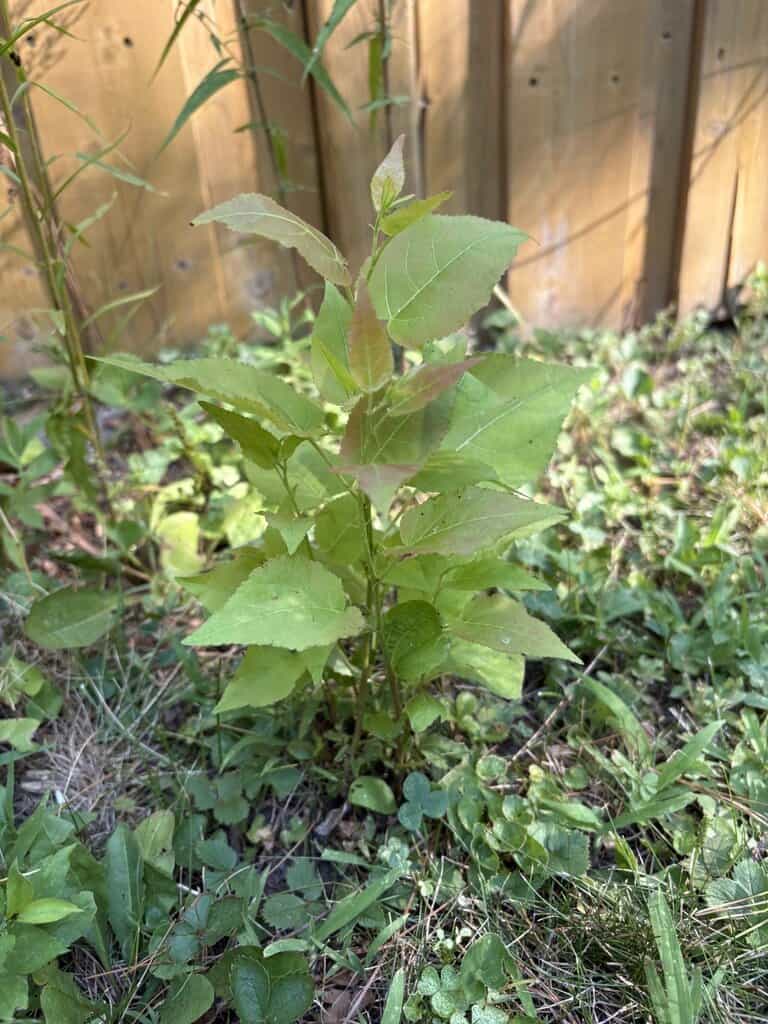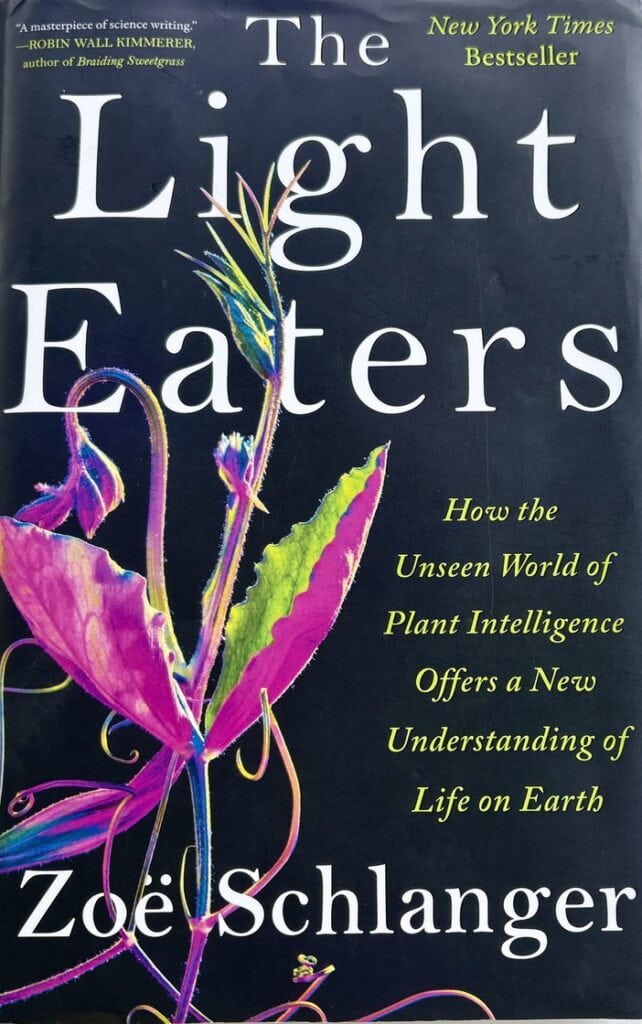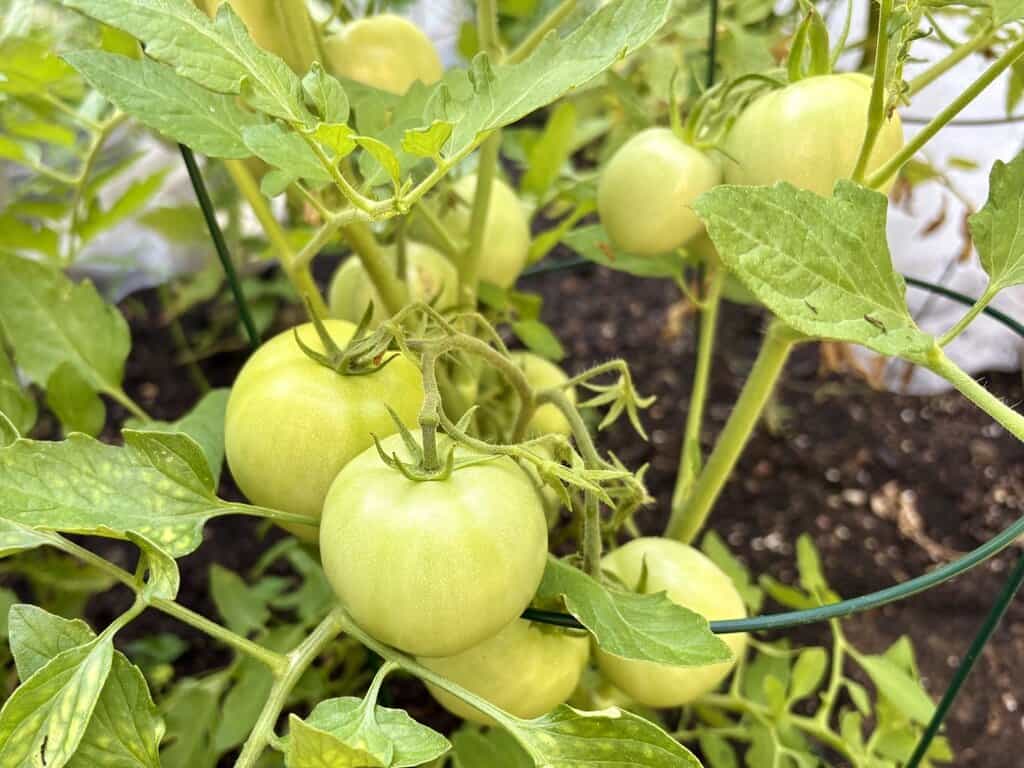Zoe Schlanger invites us to see plants not as scenery, but as agents in a living, communicating world
Peterborough Examiner – August 1, 2025 – by Drew Monkman
“They may not have neurons or brains, but they sense. They decide. They remember. And they solve problems.” – Zoë Schlanger
Returning home last week after eight days away, I was struck by a remarkable sight. Beneath our mature trembling aspen—its crown badly damaged by this spring’s ice storm—dozens of tiny aspens had sprouted in the grass. These were root suckers: genetically identical clones emerging from the tree’s underground root system.
When trees are under stress, injured, or dying, they often shift their energy to vegetative reproduction. Rather than focusing on their own survival, they try to pass on their genetic legacy by producing offspring through their roots. In our case, the tree’s reduced ability to photosynthesize—due to the loss of its canopy— triggered this impressive reproductive burst.
Witnessing this phenomenon resonated deeply with me because I had just finished reading “The Light Eaters”, a New York Times bestseller by science journalist Zoë Schlanger. Schlanger is known for her climate reporting, but she took a turn toward plant science after finding herself emotionally worn down by the bleakness of covering climate chaos.
“Plants,” she writes in the prologue, “have, over the course of years of obsession, transformed my understanding of what life means, and what its possibilities are.” Her book is part scientific exploration, part personal journey, and part philosophical inquiry. It is filled with surprising and wondrous plant behaviors that invite us to reconsider our assumptions about life, awareness, and intelligence.

Redefining Intelligence
A central question in The Light Eaters is whether plants possess intelligence. But Schlanger isn’t talking about intelligence as abstract reasoning or problem-solving. Instead, she focuses on a broader definition: “the ability to learn from one’s surroundings and make decisions that best support one’s life.”
By this definition, plants easily qualify as intelligent. They respond to environmental cues, anticipate changes, and adapt in ways that enhance their survival. They communicate, remember, and make choices—and they do all this without a brain or nervous system.
Signals and Defenses
One of the foundational studies Schlanger discusses comes from the 1970s and 80s, when researcher David Rhoades noticed that caterpillar populations in a University of Washington forest were suddenly declining. The trees, long under attack by these insects, had changed the chemistry of their leaves, making them less palatable. Even more surprising, nearby trees that hadn’t yet been attacked had also altered their chemistry. The trees, it seemed, were communicating with each other—likely through airborne chemical signals.
Schlanger also explores how plants enlist allies. Some release volatile compounds when attacked by insects, summoning wasps that parasitize the attackers. Others emit scents that attract pollinators or mimic pheromones of insects to trick them into spreading pollen.

Mimicry and kinship
Perhaps the most mind-bending account in the book is that of Boquila trifoliolata, a South American vine with the uncanny ability to mimic the leaves of the plant it climbs. In order to camouflage itself, Boquila can change not only the shape and size of its leaves but even their colour and vein patterns. Even more remarkable, the same vine can mimic multiple species at once, depending on what species it touches or grows near.
Boquila doesn’t need to be in physical contact with the plant it mimics. Researchers still don’t know how it accomplishes these impressive feats but speculate that it may involve chemical signals or light detection – possibly something akin to plant vision. The author uses this example to show that plant intelligence is not only real but operates in ways we barely understand.
Schlanger also highlights work by Canadian ecologist Suzanne Simard, who found that trees share nutrients and information through vast underground fungal networks. These networks allow trees to recognize their kin, send warnings, and even redistribute resources. Older “mother trees” support young seedlings, especially those that are genetically related.
Simard’s research upends the traditional idea of trees as competitors and instead portrays forests as collaborative communities. This new view is radically different from earlier models of plant life as passive or purely reactive.
Memory and Choice
In one chapter, Schlanger explores how plants demonstrate memory. Take the Venus flytrap: it seems to be able to sense, decide, and even remember. The plant doesn’t just snap shut randomly. Rather, it waits for specific, repeated stimulation—a kind of decision-making. Each “trap” has tiny trigger hairs but only closes after two touches of about 20 seconds. In this way it reduces false alarms like raindrops and therefore saves energy.
Schlanger also shares how beach evening primroses produce sweeter nectar when they hear the sound of a buzzing bee and how pea shoots can detect and grow toward the sound of running water.
In the garden
Gardeners who read The Light Eaters will never look at their plants the same way again. Lima beans and tomatoes protect themselves by synthesizing and releasing chemicals to summon parasitic wasps and other predators of the insects that eat them. Young sunflowers rotate their heads and leaves from east to west throughout the day as they follow the sun to maximize growth. This movement is driven not by passive bending, but by internal circadian rhythms and growth on one side of the stem, coordinated with light signals. At night, the flowers reset, turning back to the east in anticipation of dawn. The movement stops once the flower matures; it then faces permanently east to warm up faster in the morning, which attracts more pollinators.

Seeing Anew
One of the most speculative but fascinating aspects of The Light Eaters is the question of plant consciousness. There is a growing interest in science and philosophy around “panpsychism”, namely the possibility that consciousness is not something that suddenly emerges in complex brains like ours but that it might extend “all the way down” to include all living creatures including plants and even microbes.
While Schlanger doesn’t claim plants are conscious in the way humans are, she suggests they may have a distributed form of awareness. Plants take in information through their entire bodies. They assess, decide, and respond in ways that reflect agency. Even if we stop short of calling this consciousness, Schlanger argues we should at least acknowledge that plants are active participants in the world, not just scenery. They are beings that act for their own benefit.
The Light Eaters invites us to slow down and really see the plants around us. To wonder at their abilities and agency. And to imagine a world where we respect the intelligence of all life forms—not just the ones that behave in ways we understand as humans. In an age of staggering loss of biodiversity, such shifts in perspective are not just enlightening. They are essential.
For me, the sudden emergence of baby trembling aspens in our yard became more than just a biological curiosity. It was a reminder of how alive, responsive, and intentional the green world truly is.
Climate update: Record warm nights
Here’s the latest climate data for Peterborough from the CBC News Climate Dashboard at https://newsinteractives.cbc.ca/features/2023/climate-dashboard/
1. This year has seen 4 days with a nightly temperature above 20 C which is a RECORD. The average is 0 days.
2. There have been 13 days above 30 C in 2025. That’s 7 days above average.
3. The average maximum temperature for the last 30 days is 28.9 C. This is 2.8 C above average.
4. The total precipitation for the last 30 days is 53 mm. This is 18.1 mm below average.
5. Atmospheric CO2 for July 29 was 426.67 parts per million (ppm), which is 1.46 ppm higher than a year ago. This is a stark reminder that our use of fossil fuels is pushing CO2 in the atmosphere well beyond the highest safe level of 350 ppm. (Data from https://www.co2.earth/daily-co2)